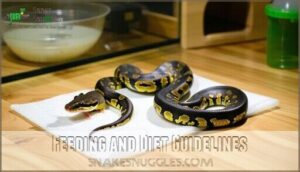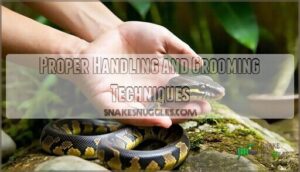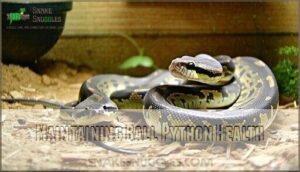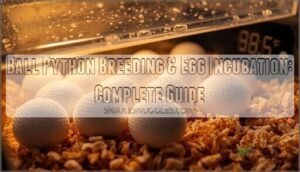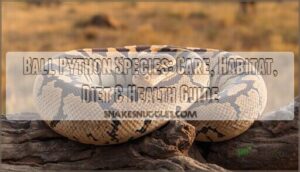This site is supported by our readers. We may earn a commission, at no cost to you, if you purchase through links.
 Most new snake owners expect their ball python to eat every week like clockwork, but these snakes regularly fast for months without any health issues. This natural behavior throws beginners into panic mode, convinced their pet is sick or dying. Understanding the difference between normal fasting and actual illness is just one piece of the puzzle regarding ball python care.
Most new snake owners expect their ball python to eat every week like clockwork, but these snakes regularly fast for months without any health issues. This natural behavior throws beginners into panic mode, convinced their pet is sick or dying. Understanding the difference between normal fasting and actual illness is just one piece of the puzzle regarding ball python care.
These snakes need specific temperature gradients, appropriate prey sizes based on body weight, and careful socialization to thrive in captivity. Getting the basics right from day one prevents most health problems and creates a rewarding experience for both you and your snake over its three-decade lifespan.
Table Of Contents
Key Takeaways
- Ball pythons naturally fast for months without health issues, making it crucial to distinguish normal seasonal behavior from actual illness rather than panicking over feeding refusals.
- Proper habitat setup requires precise temperature gradients (88–92°F basking, 76–80°F cool side) and humidity control (50–60% normally, 70–75% during shedding) to prevent respiratory infections and skin problems.
- Feeding schedules should match the snake’s age and weight—juveniles need meals every 5–7 days while adults only require feeding every 10–14 days, with prey size matching the snake’s mid-body width.
- Regular handling 2–3 times weekly builds trust without causing stress, but these solitary animals should never be housed together as cohabitation triggers competition and health problems.
Ball Python Characteristics and Behavior
Before you bring home a ball python, you need to know what you’re getting into. These snakes have distinct physical traits, predictable behaviors, and specific care needs that shape your daily routine.
Here’s what you need to know before bringing one home.
Lifespan and Size Expectations
When you bring a ball python home, you’re not just getting a pet for a few years—you’re making a commitment that can stretch across three decades if you do things right. With proper care, your ball python can live 30 years or more in captivity.
Adult size generally reaches 4 to 5 feet, though sexual dimorphism means females often grow slightly larger than males. Most ball pythons hit their maximum size around three years old.
Common Morphs and Color Patterns
Ball python morphs showcase the species’ striking genetic diversity. The wild-type pattern features dark brown blotches on lighter tan or gold backgrounds. Through selective breeding, breeders have produced hundreds of variations.
Popular examples include:
- Albino morphs – lacking black pigment, displaying yellows and whites
- Piebald morphs – featuring unpigmented white patches alongside normal coloration
- Pastel morphs – showing enhanced yellows and reduced dark patterning
- Clown morphs – presenting altered head patterns and body markings
Understanding snake genetics helps you identify morphs and predict breeding outcomes. Ball pythons exhibit thousands of different color and pattern combinations. Some of the rarest morphs command premium prices due to their unique genetic inheritance patterns.
Behavioral Traits and Temperament
Beyond their stunning appearance, ball pythons have earned their reputation as one of the most docile snake species you can keep. Their calm temperament makes regular interaction easy, though they’re solitary creatures that don’t require social interaction.
In captivity, these crepuscular snakes adapt well to human schedules. You’ll notice they rarely display defensive behaviors like striking or biting. Their shy nature means they often curl into a protective ball when startled—that’s actually how they got their name.
Nocturnal Habits and Activity Levels
Your ball python’s internal clock runs on a nighttime schedule, which means you’ll see them come alive once the sun goes down. These nocturnal species naturally hunt and explore during dark hours, so don’t worry if your snake stays hidden during the day.
You’ll want to schedule feeding sessions after dusk when their hunting instincts kick in. If you’re curious about their nighttime behaviors, use a dim nocturnal or infrared light to watch without disrupting their activity cycles.
Setting Up a Ball Python Enclosure
Your ball python’s enclosure is more than just a container—it’s the foundation of their health and well-being. Getting the setup right from the start means less stress for your snake and fewer problems down the road.
Here are the essential components you’ll need to create a safe, comfortable habitat.
Minimum Tank Size by Age
A cramped enclosure won’t just limit your snake’s movement—it can lead to stress and health problems down the road.
Hatchling tank size starts at 10 gallons, but juveniles quickly need 20 gallons as they grow. Once your ball python reaches adult size, plan an adult tank upgrade to a breeder tank—at least 40 gallons.
Vertical space considerations matter less than floor area since these snakes prefer ground-level exploration.
Creating a Secure and Escape-Proof Habitat
Even though ball pythons seem docile, they’re surprisingly talented escape artists if given half a chance. Your snake habitat setup depends on secure lid security—use a tight-fitting, screened top with locks or heavy clips.
When setting up your ball python’s home, you’ll need these basics:
- Proper hiding spots that prevent wedging or gaps
- Sealed cable management holes for wires
- Smooth tank material without cracks
Check all enrichment items regularly to prevent your snake enclosure from becoming an exit route.
Essential Heating and Lighting Equipment
Getting your ball python’s enclosure right means setting up proper reptile heating and lighting—it’s essential for their health and digestion.
Heat lamps or a heat emitter need to keep the warm hide between 86–90°F, and you’ll want nighttime heating devices like ceramic emitters to maintain temps after dark without any visible light.
Here’s the critical part: always run your heat sources through a thermostat to prevent burns and dangerous overheating.
Different bulb types, from halogens providing quality infrared radiation to UV light emitters, serve distinct roles. Ball pythons benefit from consistent light cycles mimicking their natural habitat. Follow wattage guidelines based on your tank size, and use an infrared thermometer to verify surface temps.
Recommended Substrate Options
Choosing the right substrate isn’t just about looks—it’s the foundation of your ball python’s comfort, safety, and overall health. Popular snake substrate options balance humidity control with odor control and cleaning frequency. Avoid cedar or pine, which release harmful oils, and watch for impaction risks with loose particles.
- Cypress mulch: Holds substrate moisture levels well for proper ball python care while resisting mold
- Coconut husk: Substrate brands like Eco Earth excel at humidity control and odor absorption
- Paper towels: Simplest for monitoring health and frequent cleaning in snake habitat setup
- Aspen shavings: Affordable but requires more frequent changes in high-humidity environments
Humidity and Temperature Requirements
Your ball python’s enclosure needs to mirror its natural African habitat—get the temperature and humidity wrong, and your snake won’t just be uncomfortable, it’ll struggle to survive.
Set up a basking spot between 88°F and 92°F, keep the cool side at 76°F to 80°F, and maintain the overall enclosure temperature around 80°F to 85°F.
Keep humidity levels steady at 50% to 60%, bumping it to 70% to 75% during shedding. Use a digital hygrometer for humidity monitoring to catch problems early and prevent shedding issues before they start.
Feeding and Diet Guidelines
Getting your ball python’s diet right is one of the most important parts of keeping them healthy. We’ll cover what to feed them, how often meals should happen, and how to do it safely.
That way, your snake gets proper nutrition without any guesswork.
Choosing The Right Prey Size
Getting the prey size right isn’t guesswork—it’s the difference between a healthy meal and a dangerous one for your ball python.
Your rodent size guide is simple: choose frozen rodents or prekilled rodents that match your snake’s width at mid-body.
Feeding oversized prey risks impacted snakes, while undersized pinkies or multiple prey items can lead to obesity risks.
Stick to appropriately sized frozenthawed options for safe ball python feeding.
Feeding Frequency for Juveniles Vs. Adults
Once you’ve nailed prey size, your feeding schedule matters just as much. Juveniles under 300g thrive on feeding sessions every five to seven days—consistent meals fuel rapid growth without the Powerfeeding Dangers that shorten longevity.
Adults shift dramatically: males over 800g need meals every 10–14 days, while large females eat weekly. This mirrors Natural Feeding Patterns, where wild adults average just 10 meals yearly.
Don’t panic during Seasonal Fasting—reduced appetite in cooler months is normal Ball Python Feeding behavior, balancing Growth vs. Longevity through Weight-Based Schedules and a thoughtful rodent diet.
Safe Feeding Practices and Tools
Using feeding tongs keeps your fingers safe and prevents your snake from mistaking your hand for dinner. Follow these snake feeding essentials:
- Thaw frozen rodents in warm water for 30 minutes—never microwave.
- Use 12-inch feeding tongs to maintain distance during strikes.
- Avoid live prey—it can injure your python.
- Pick up frozen rodents with tongs, not bare hands.
- Feed in the enclosure to reduce bite risk during transfers.
Proper rodent thawing methods and feeding tongs safety protect both you and your snake.
Water Bowl Maintenance and Hydration
Your ball python needs fresh water every single day—not just for drinking, but also for soaking during sheds. Choose a water bowl size that lets your snake submerge at least half its body. This humidity control helps prevent stuck skin during shedding.
Clean water sources support proper hydration signs like bright eyes and smooth scales in your ball python’s snake habitat.
| Maintenance Task | Frequency |
|---|---|
| Replace water | Daily |
| Scrub bowl | Every 2-3 days |
| Disinfect thoroughly | Weekly |
| Check for debris | During each feeding |
Proper Handling and Grooming Techniques
Picking up your ball python correctly builds trust and keeps both of you safe during interactions.
These techniques also cover the basics of enclosure maintenance and supporting your snake through natural processes like shedding.
Let’s walk through the essentials you’ll need to master as a new keeper.
Here are the core skills every new ball python owner should know.
How to Safely Handle Your Ball Python
Interacting with a ball python isn’t like picking up a garden hose—it requires patience, respect for the animal’s body language, and a few simple techniques that keep both you and your snake comfortable. Start with safe lifting: support the snake’s body in multiple places, never grabbing the head or tail. Watch for stress signals like defensive coiling or hissing.
Interact with your python two to three times weekly—enough for socialization without overwhelming them. Supervise children closely during interactions to prevent snake bites and make certain your ball python’s gentle temperament shines through.
Socialization Tips for Shy Snakes
Some ball pythons act like they’d rather hide under a rock forever than say hello—but with the right approach, even the shyest snake can learn to tolerate and even enjoy human interaction.
Start with brief, gentle sessions—just five minutes—and gradually increase interaction frequency as your snake relaxes. Trust building takes time, so watch for stress signals like rapid tongue flicking or tight coiling.
Provide hiding areas in the enclosure so your python feels secure between interactions, and you’ll notice their snake temperament soften over weeks of consistent, positive reinforcement.
Cleaning and Disinfecting The Enclosure
A clean enclosure isn’t just about looks—it’s your first line of defense against respiratory infections, scale rot, and parasites that thrive in dirty conditions.
Remove waste daily with spot cleaning, and replace your snake substrate every month.
Use a reptile-safe habitat cleaner or diluted bleach solution to disinfect surfaces, preventing mold growth. Frequency matters—your python’s health depends on consistent snake enclosure maintenance.
Shedding Support and Skin Care
When your ball python’s eyes turn milky blue and its colors fade, shedding is around the corner—and you’ll need to step in if humidity levels drop too low.
Boost humidity to 70% during shedding cycles by misting the enclosure or adding damp snake substrate. This prevents stuck shed on eye caps and scales.
If pieces remain after the shedding process, soak your python in lukewarm water for 15 minutes—never pull stuck shed, which risks abrasions and skin infections.
Maintaining Ball Python Health
Your ball python’s health depends on catching problems early and taking the right steps to prevent them. Learning what’s normal for your snake makes it easier to spot when something’s off.
Here’s what you need to know to keep your python thriving for decades.
This is what keeps your python healthy for the long haul.
Recognizing Signs of Illness
Detecting ball python health problems early can prevent serious snake diseases. Watch for respiratory distress like open-mouth breathing or bubbling, which affects over half of infected pythons.
Skin abnormalities—lesions, retained shed, or unusual discoloration—signal trouble.
Behavioral changes such as lethargy or abnormal posture require immediate attention.
Fecal changes in color or consistency, along with feeding issues beyond normal seasonal fasting, are red flags warranting a reptile vet visit.
Annual Veterinary Care and Check-Ups
Routine veterinary visits aren’t just about treating problems—they’re your best defense against silent health issues that often go unnoticed until it’s too late.
A reptile vet conducts annual examinations to screen for internal parasites, assess skin infections, and detect early respiratory issues. This preventative care approach catches anorexia treatment needs and other ball python health concerns before they escalate, ensuring your snake thrives for decades.
Preventing Common Health Issues
Most ball python health issues stem from environmental mistakes you can fix today. Respiratory infections thrive when enclosure temperatures dip below 78°F or humidity strays from the 50–60% sweet spot.
Scale rot develops when substrate stays damp—switch to aspen bedding and spot-clean daily.
Shedding problems signal dehydration, so bump humidity to 70% during shed cycles.
Weekly disinfection with 3% bleach solution addresses oral infections and other medical problems before they escalate into serious snake health crises.
Managing Feeding Refusals and Stress
Your ball python’s sudden hunger strike doesn’t mean it’s sick—winter months and shedding cycles naturally suppress their appetite for weeks at a time.
Check your snake behavior first: stress reduction starts with reducing interaction techniques during these periods. Verify your environmental enrichment meets temperature needs before considering veterinary intervention.
Most feeding sessions resume once the stress causes disappear, making patience your best tool.
Frequently Asked Questions (FAQs)
Can ball pythons live together in one enclosure?
No, ball pythons shouldn’t live together. These solitary reptiles experience significant stress factors when cohabiting.
Feeding competition creates conflict, and individual personalities clash in shared enclosures.
Space requirements and proper reptile husbandry demand separate habitats to prevent stress-related health issues.
What are signs of a healthy ball python?
Healthy ball python characteristics include clear eyes without cloudiness, intact skin free of wounds or retained shed, and a clean vent.
Regular shedding cycles, consistent weight, and active tongue flicking during interaction also signal proper reptile husbandry and overall wellness.
How often should you handle your snake?
Less is more when building trust with your new companion. Interact with your ball python two to three times weekly for 10-15 minutes once it’s eating regularly.
This Interaction Frequency helps juvenile animals acclimate without triggering Stress Indicators like defensive posturing or refusal to feed, while Safe Techniques during Ball Python Interaction sessions support healthy Snake Temperament development.
Do ball pythons need UV lighting in captivity?
UVB benefits for ball pythons remain debated. While D3 synthesis occurs naturally through diet, some keepers provide low-level UVB on a 12-hour lighting schedule to mimic wild behavior and support overall health, especially with morph sensitivity considerations.
The UVB question for ball pythons isn’t settled. These snakes synthesize vitamin D3 from their food, but some keepers add low-level UVB lighting for 12 hours daily anyway—it might encourage natural behaviors and support health, particularly in morphs prone to certain sensitivities.
What substrates are unsafe for ball pythons?
Avoid pine and cedar shavings, which release aromatic oils toxic to reptiles.
Dusty substrates can cause respiratory problems, and sharp materials may injure your snake.
Safe options include aspen wood shavings, cypress mulch, coco coir, or orchid bark.
Conclusion
A ball python that refuses food for two months isn’t necessarily sick—it’s following instincts honed over millennia in West African savannas. Your success with ball python care hinges on respecting these patterns rather than fighting them.
Temperature precision matters more than expensive decorations. Consistent routines build trust faster than daily interaction.
When you align your expectations with their biology instead of forcing them into yours, these docile snakes transform from mysterious reptiles into predictable, low-maintenance companions that thrive for decades.
- https://image.petmd.com/files/2024-12/1730300-24-10-PMD-BallPythonCareSheetPrint.pdf?VersionId=Fv06m3ReK50k_ySRUP.LbxXxGfkoQWD8?utm_source=petmd.com&utm_campaign=caresheet&utm_medium=PDF
- https://journals.biologists.com/jeb/article/218/14/2279/14389/Snake-constriction-rapidly-induces-circulatory
- https://www.researchgate.net/publication/232678980_Sex_Differences_in_Body_Size_and_Ectoparasite_Load_in_the_Ball_Python_Python_regius
- https://www.reptifiles.com/responsible-reptile-breeding/
- https://prf.hn/l/o3BEMME






